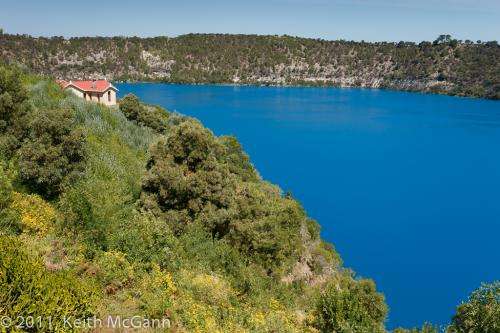Australian volcanoes form case study for dating technique

Volcanos in south-eastern Australia are still considered active, and a PhD candidate is hoping to determine whether we might expect more eruptions any time soon.
The Newer Volcanics Province includes more than 400 volcanoes, stretching from the Central Highlands north of Melbourne to South Australia's Mount Gambier district.
Curtin University Geologist and PhD candidate Korien Oostingh says it is a very young geological province.
"It started erupting 4.6 million years ago and the last eruption [at Mount Gambier] is actually thought to have been witnessed by Aboriginal people around 5,000 years ago," she says.
She is using the province as a case study as she develops a new technique that makes use of cosmogenic radiation for dating purposes.
Ms Oostingh has travelled to many locations throughout the Newer Volcanics Province, collecting samples that she is subjecting to tests at Curtin University's Argon Laboratory.
"I'm looking at olivine in basalts," she says.
"Part of the calcium in olivine will be converted into an isotope of Argon, [Argon 38] that we can measure here for the first time quite reliably in Curtin University.
"I will also combine that with chemistry data on the rocks from the new volcanic province so that I can look at some trends in the area and hopefully answer two big questions.
"One of them is if we can expect new eruptions in an area in the near future.
"Also, where the basalts were actually coming from at some point, so what is the source in the deep sub-surface?"
The province is more than 2000km from the edge of the Australian tectonic plate.
Ranging theories behind region's volcanic activity
She says there are two current hypotheses proposed to explain this "intra-plate" volcanism.
"One possibility is that it is caused by the principle of a mantle plume," she says.
"A mantle plume is rising magma from very deep in the earth—a little bit like if you are making a soup, the very hot material in the middle starts to rise.
"Very hot magma rises in pockets and it all starts to rise to the surface and creates a volcanic province or volcano.
"Some other people propose some local inhomogeneities in the underlying mantle."
Ms Oostingh says she is not yet inclined to support either hypothesis.
"I am hoping to gain completely new data and to put forward my own model, I will do some advanced modelling here," she says.
Provided by Science Network WA




















